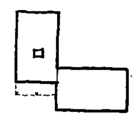Look at charming buildings anew to understand how they captivate you
A charming building can take my breath away, much as the Harpswell, Maine cape did when my husband and I first drove by it. The red colonial (see below) is another charmer. It has often been featured on the Secret Garden Tour in Newport, Rhode Island. The little bungalow (also below) is dear to my heart too, in part because it’s my parents’ house in Connecticut, and because of its storybook hominess.
These three New England homes exude charm. Why? What is it about these that is so pleasing? Perhaps if we look at them together and consider what they have in common we can identify the ingredients vital to a recipe for charm.
Granted, these are all older homes, but charm needn’t be relegated exclusively to by-gone eras. With our recipe in hand to inform us, we should be able to design charming new homes and renovations -- not imitations or replicas but buildings inspired by the characteristics that these homes share. Like any good recipe there should be wiggle room for innovation, occasional substitution, and regional adaptation, but at its core a recipe for charm should be timeless.
grounding rooflines
The rooflines of these three are all different.
- The Harpswell house includes two gable* roofs and a shed* porch roof.
- The Newport colonial has a gambrel* roof.
- The bungalow has a hipped* primary roof with a hipped gable* dormer and a hipped porch roof.
Despite these differences, each is one-and-one-half stories, which means each has one full story bound by exterior walls and an upper partial story under the sloped roof. This keeps them modest in scale and well grounded.
A grounding roof approaches the ground as it shelters the building and sheds water downward. When a first story porch wraps across an end wall or entrance as it does in the Harpswell house and Connecticut bungalow, it further grounds the building and minimizes its scale. Keep in mind that “scale” is a relative term, referring to the human scale. If you were to stand alongside these buildings their mass or scale would not overwhelm you; the eave line would not be far out of reach.
legible massing
These all also have simple overall massing. “Massing” describes three-dimensional form and its related bulk or disposition. A building’s mass may be distributed a number of ways.
- The Harpswell house is roughly formed by two gables that abut at perpendicular corners leaving an open space rather than wrapping into a continuous ell.
- The Newport colonial forms a more common ell (though only one wing is shown in this photo).
- The bungalow is essentially a central block with minor extensions from the core.
Their geometries and footprints are easy to understand and thus, one would imagine, easy to navigate too -- which makes them legible.
engaged relationship with landscape
Each has an integral relationship with the landscape.
- The Harpswell house rests quietly within a dreamy flat meadow with a lush sheltering backdrop of deciduous trees and conifers that extend from about eave height to well above the chimney. A close look will reveal a neatly trimmed lawn immediately around the house that is then allowed to merge effortlessly with the soft meadow in the foreground.
- The Newport colonial is buffered by densely planted colorful wildflowers that enjoy the southern exposure, and by an untrimmed privet hedge that provides fence-height privacy.
- The bungalow is bordered by dancing, sill-height rose bushes and a tightly planted under-course of round boxwoods that follow a curved contour. Together these plantings ease the transition between angular house and lawn without obscuring desirable sunlight or breezes.
simple color palette and harmonious materiality
One of the first things to register about the Harpswell house is the stark all-white wood clapboards, windows, and trim punctuated with a red door, red brick chimney, and natural cedar shingle roof. The color palette is spare and a delightful contrast with the natural green of summertime. On the other hand, with its preponderance of white wood, the house would be in near full camouflage in a winter-white landscape, as if to remind us that the house is very much part of the landscape. The materials themselves are derived from a similar natural environment.
The Newport colonial also makes a simple color statement. The all red wood clapboards, windows, and trim carve a clean, simple silhouette against the blue sky and the green plantings. Tying the red color of the house into the red color of the fence further delineates building elements from the landscape. In a winter-white landscape the red built structures would stand out even more starkly. No matter how hard the little red house may try to distinguish itself from the environment with its bold red palette, it too is composed of the very materials that surround it: wood, stone, and earthen brick.
The bungalow’s palette is more varied, but subtly so. The beige wood, side-wall shingles are gently offset by the white windows and trim. The blue-green door adds a touch of vibrant color to mark the front the entrance. Here the windows have a greater presence than in the other houses where there are a few discreet openings within larger expanses of wall. The white trim that surrounds the bungalow’s windows dominates the palette. The black of the reflected glass in the ganged front casement windows is modulated by the crisp white muntin bars. Here, too, natural materials reign.
thoughtful details
The attention to noteworthy details in each of these three houses is another hallmark of their charm. The Harpswell house’s horizontal rake* and frieze* trim that runs between the taller gable and shorter perpendicular gable is instantly distinctive. Like a song that you can recognize from the first few bars, a close-up of that detail alone would be enough for you to identify this house. On the one hand, that horizontal moment at the roof intersection is a little bizarre; on the other, it tells the story of how these two volumes came to be joined over time. Theirs is a relationship that evolved most likely from a practical need to grow.
At the Newport colonial the back of the bee-hive oven (that bulges from within the stone masonry on the end elevation) is unabashedly unique. The fact that its placement is off-center within the surrounding masonry only further accentuates its eccentricity. Architects are generally suckers for form that reveals function, but surely this is a detail that would charm any fan of New England ingenuity.
The bungalow has less conspicuous notable details, but charming ones nonetheless. The wide porch pilasters* on the shingle half wall and repeated narrow double hung windows are among them.
recipe for architectural charm
ingredients:
- grounding roof lines
- legible massing
- engaged relationship with landscape
- simple color palette and harmonious materials
- thoughtful details
Create legible massing with grounding roof lines to modulate scale. Choose forms and siting that engage the landscape and natural forces. Incorporate a simple color palette and harmonious materials. Add thoughtful details and ruminate until your creation has risen to the charm challenge.
Let’s put what we’ve learned to use. Slapdash imitations and ungainly, ill-conceived alternatives abound. Anyone can whip up processed Kraft macaroni and cheese. But it’s the inspired cook that can concoct a new mouth-watering, custom-made rendition of the comfort-food staple. Let’s take the time and thought to create original new houses and renovations informed by these three charming architectural precedents.
by Katie Hutchison for the House Enthusiast
- * A gable roof has a peaked ridge with a simple downward slope on each side. A shed roof has a single slope. A gambrel roof has a central ridge with two downward roof pitches on each side. A hipped roof slopes in from all sides to a point or ridge line. A hipped gable is a gable roof that meets the end wall with a minor hip roof. The rake is the projecting edge where the roof meets an end wall. The frieze is the wall trim directly below the rake or eave. A pilaster is an engaged post or column formed against a wall.









